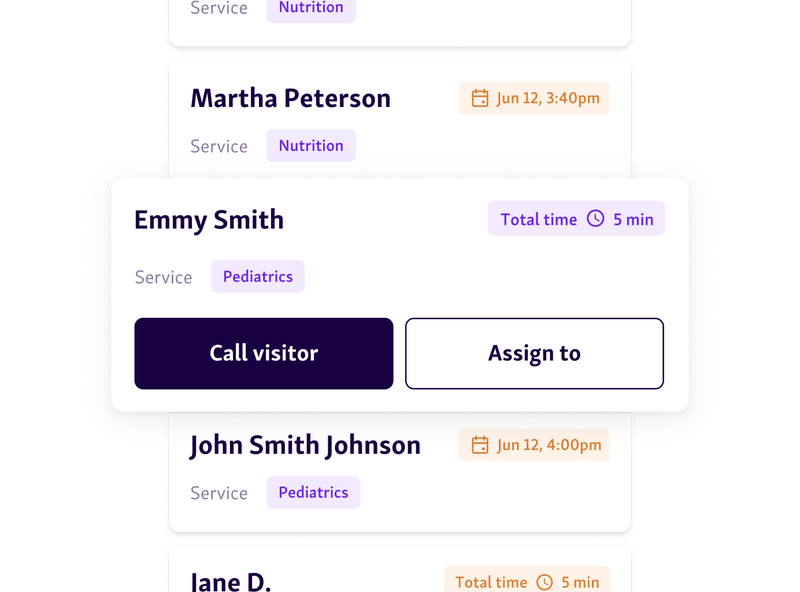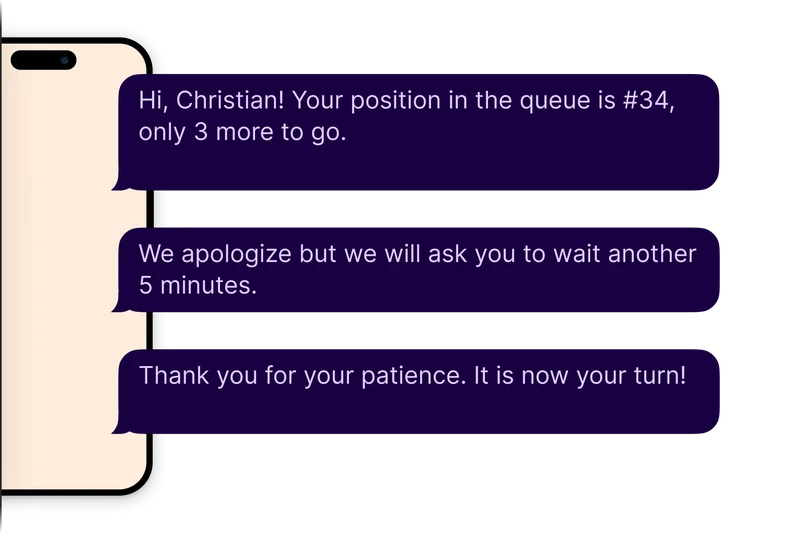Frontline teams are the face of government service. They shape how citizens feel about every visit. When things are slow, confusing, or impersonal, it’s usually not policy people blame, it’s the experience they just had.
Back in 2021, citizen satisfaction with U.S. federal services dropped to 63.4%, the lowest on record. The reasons were clear: long waits, unclear steps, mixed messages.
If CSAT is going to improve, it starts at the front desk and service counters. That’s where staff can cut friction, build trust, and make the process feel smoother day to day.
In this article, we’ll explore the common factors that impact satisfaction and share practical ways frontline staff can improve service delivery every day.
Key Challenges That Frontline Teams Face
Frontline staff are usually the first people citizens meet. The pressure they deal with shows up directly in satisfaction scores. To improve CSAT, you first have to look at the daily problems they run into.
Long Wait Times and Citizen Frustration
When lines drag on, frustration builds fast. Frontline teams end up taking the heat. Without tools to manage queues, staff are stuck juggling heavy traffic while trying to keep things steady.
Inconsistent Communication
A lot of citizens walk in missing documents or unsure of the next step. Most of the time, that’s because communication between departments, or between online and in-person, doesn’t line up. Staff spend time repeating answers, which slows service for everyone else.
Outdated Tools and Processes
Plenty of offices still rely on manual check-ins, paper forms, or software that doesn’t connect well. Those outdated setups drag down every part of the visit and leave staff blind to what’s happening in the overall queue.
Staff Workload and Burnout
Many government offices run short-staffed, even during peak demand. Employees face long lines, upset visitors, and complex requests with little backup. Over time, that wears people down. Burnout leads to turnover and uneven service quality.
How Frontline Teams Can Drive CSAT in Government Services
Frontline teams play a critical role in shaping how citizens experience government services, through the speed, clarity, and care they provide. Let's explore some practical, frontline-driven strategies:
1. Reducing Wait Times with Queue Management Tools
Long wait times frustrate people using government services. Crowded lobbies and unclear processes only add to it, and frontline teams end up carrying the stress from both sides.
Queue management tools change that.
With virtual queues and appointment systems like Qminder, staff can guide traffic instead of just reacting to it. Citizens check in remotely, get real-time updates, and know where they stand. It cuts confusion and lowers tension.

How it works:
Minimize congestion: Citizens can wait somewhere else.
Set expectations: Live updates keep people in the loop.
Improve flow: Staff see demand and adjust in real time.
Support accessibility: Flexible check-in and virtual queuing for everyone.
2. Improving Communication and Transparency
Long wait times aren’t the only source of frustration. Not knowing what’s going on makes things worse. When citizens don’t have clear updates, anxiety builds fast. Frontline staff end up carrying the load, answering the same questions again and again.
With queue management tools, teams can send live SMS alerts, run queue displays, and keep people updated without constant face-to-face explanations. That means less pressure on staff and fewer confused visitors.

Here’s how it works:
SMS alerts: Citizens get messages with their status and estimated wait time.
Queue displays: Real-time updates show clearly in lobbies and waiting areas.
Delay notifications: Send quick alerts when things change to cut down on frustration and build trust.
See also: How to Improve Customer Communication with SMS Text Messaging
3. Personalizing the Citizen Experience
Nobody wants to feel like a number. That’s especially true when dealing with essential public services. Long waits and one-size-fits-all processes only add to the frustration. Frontline staff can change that. They can make the interaction feel personal, not routine.
With the right tools, staff adjust how they serve different needs—through priority queuing, custom appointment types, or simple updates that fit the situation.
Here’s how it works:
Custom appointment flows: Citizens book times for the service that matches their visit.
Priority queues: Extra support for seniors, people with disabilities, or urgent cases.
Personalized updates: Real-time alerts sent based on queue status.

When people feel seen and accommodated, they leave with less stress. And that’s what moves the CSAT scores up.
Read also - The Power of Using Customer Names to Create Personalized Experiences
4. Training and Supporting Frontline Staff
The way staff interact with citizens has a direct impact on satisfaction. Frontline employees are often the only human connection in a public service experience, and how they handle that interaction matters more than any piece of technology.
Even with the best systems in place, CSAT will suffer if staff aren’t equipped with the skills and support they need.
Here’s how to make it work:
Empathy training: Help staff respond with patience, understanding, and respect
Clear process knowledge: Equip them to explain policies and next steps simply and confidently
Stress-reduction programs: Support staff well-being to avoid burnout and boost morale
When frontline teams feel confident and cared for, they deliver better service—and it shows in citizen satisfaction.
5. Use Digital Tools and Online Services
It’s 2025, citizens shouldn’t have to stand in line for tasks that could be handled online or at a kiosk. Digital tools and government online services are designed to simplify processes, but their impact depends on how well they’re used on the ground.
Frontline staff play a key role here. By guiding citizens to the right self-service kiosk options, they reduce congestion and give people more control over their time.

Here’s how it works:
Online booking: Help visitors schedule appointments ahead to avoid walk-in backups
Digital forms: Direct citizens to fill out paperwork remotely, before arriving
Self check-in kiosks: Empower visitors to check in, update info, or even complete simple tasks independently
When staff encourage digital adoption, it frees up time for everyone—and boosts overall satisfaction in the process.
You might also like - Customer Satisfaction – Make Your Customer Addicted to Your Business
The Long-Term Impact of Empowering Frontline Teams
Putting resources into frontline teams doesn’t just fix daily interactions. It changes how government service is delivered and how people see it. When staff are set up to succeed, the effects spread across the system.
Stronger Citizen Trust and Compliance
When service feels clear, respectful, and efficient, citizens are more likely to trust it—and stick with it. Renewing a license, filing forms, following through on tasks all get easier. Better experiences mean fewer drop-offs.
Improved Staff Morale and Lower Burnout
Happier citizens lead to smoother days. Less frustration at the counter takes weight off staff. Morale rises, stress drops, and burnout slows down. Support the people doing the work, and they’ll give more back.
A Modern, Efficient Government Image
Digital tools and better processes make frontline teams look modern and prepared. Whether it’s city hall or the DMV, these changes show citizens that the government can be efficient, responsive, and easier to deal with.
Helpful read - 9 Proven Benefits of Online Queue Management Systems
Empowering Frontline Teams to Drive Long-Term CSAT Gains
Improving CSAT isn’t just about quick fixes, it’s about equipping frontline teams with the tools and support they need to deliver consistently better service. When wait times shrink, communication improves, and citizens feel seen, satisfaction naturally rises.
Over time, these improvements build trust, reduce pressure on staff, and reshape how the public views government services.
Qminder’s queue management system empowers frontline staff to manage flow, reduce stress, and keep citizens informed at every step.
Start your free 14-day trial with Qminder and help your team deliver the service your citizens deserve.
Survey scores are just one piece. Teams can also track first-contact resolution, average wait time, service time per visitor, and how often people come back with the same issue or file complaints. Those numbers show if changes are making a real impact on satisfaction.
Short surveys after a visit work best. Send them by SMS or email, keep it to 1–3 questions, and send them quickly while the experience is fresh. Simple and timely gets more responses and gives frontline teams feedback they can act on right away.
No. Tools like Qminder are built to be simple and easy to pick up. Minimal training is enough. The goal is to back up staff with support, not load them with extra tech work.





